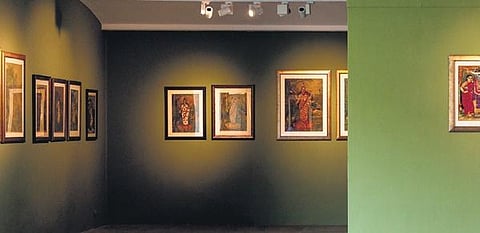

Rising from a river, standing on a lotus, draped in a sari—goddess Lakshmi would not have been embellished in our imagination in the way she is, had Raja Ravi Varma not wielded his brush in the now-familiar neoclassical style. It was 1894. Varma set up his lithographic press in Mumbai with the help of Sayajirao Gaekwad III, the Maharaja of Baroda, who had commissioned him to produce his first series of mythological characters.
“This democratised the distribution of God’s imagery,” says Anubhav Nath, the Curatorial Director of Delhi’s Ojas Art Gallery. “Now, when 1.2 billion Hindus think of Lakshmi and Saraswati, the imagery that actually comes to mind is invariably Raja Ravi Varma’s.”
In the gallery’s current showcase, ‘The Divine Deities’, the painter’s embellished oleographs attest to the hold these 10”x 14”, over-a-century-old paintings have had on the public imagination. Saraswati, gracefully seated with her Veena, and poignant scenes from the Ramayana—depicting Lakshman and Sita, on either side of Rama, while Hanuman knelt at his feet—have become a visual hymn in households across the nation.
Deities on the calendar
However, what is common to us now, was not the case before 1881. Before Varma painted his first series of mythological paintings, “the imagery of Gods and Goddesses was rudimentary”. But with the advent of the press, no longer was the image and the idea of God, or even divinity, confined to the precincts of temples in the form of sculptures. Varma’s artistic tapestry transcended the confines of courts in the true sense, finding its way into the homes through prints, and calendar art, allowing everyone, including those from the lowest strata of society, to find creative ways of worship. These prints appeared on shop walls, calendars and ticket labels, which were collected and hung on the walls of puja rooms.
Changing the nature of worship, divine imagery was now part of almost every household, allowing even those who were prohibited from entering the temples to worship. The mass production of the prints not only mainstreamed the Hindu gods and goddesses but also imprinted itself on the collective consciousness of a billion devotees.
Amalgamation, always
Varma’s work has also been marked by syncretism. Influenced by French and Italian paintings, his imagery of women was a perfect example of what some may call the marriage of a certain ‘Indianness’ with western techniques. It reflected in how he consciously chose to portray women: he painted them in the backdrop of bright colours; their demeanour, dress and features were apparent in the aristocratic women from the neoclassical paintings.
“He allowed western influences to prevail when and where it suited him, and from which he knew he could derive the maximum advantage,” writes Rupika Chawla, art curator and author in her book, Raja Ravi Varma: Painter of Colonial India.However, his art was not admired by all. Some found the figures too voluptuous and thought it was necessary to cover them.
“What we do not talk about is Varma’s influence on the material culture and fashion,” says Nath. “With the advent of sewing machines, people were now able to stitch clothes and decorate the prints. The prints, which were too voluptuous for people to digest, paved the way for the culture of decorating and embellishing of the deities.” The result was that people started ‘dressing’ their deities in clothes or intricate zari work. Many went a step ahead and used gold or silver powder, or pearls and mirrors to embellish the oleographs.
Driving Inspiration
Some of the popular calendar art, apart from images of goddess Saraswati, Lakshmi and the famous scene from Ramayana, are the Vishnu Garud Vahan, in which Vishnu rides on his half-bird half-human mount Garuda, or Kali in rage with her tongue out wearing a garland made of beheaded rakshasas stepping on a supine Shiva.
These, with little tweaks and reinterpretations, have further found their way into the most known pages of history and literature, including the comic-book series of the Amar Chitra Katha.Others have been reproduced in the form of music, films, advertising and even textiles. “An imagery, which is more than 120 years old, has penetrated every household. I do not see any other artist in the world to have such an impact on such a large population,” says Nath.
‘The Divine Deities’ is on at the Ojas Art Gallery,Mehrauli, till December 6